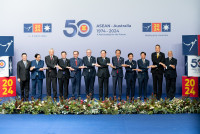KUALA LUMPUR – Despite hiccups brought on by the volatile global environment in the first half of 2023 (1H2023), Malaysia’s economy is set to navigate through the second half journey on continuous support from strong households, intact economic fundamentals and improved outlook.
Economic experts are in view that the gross domestic product (GDP) target of between 4 and 5% set by the government for 2023 is achievable and the country is on track to realise it.
They also believed that the external variables influencing growth, which impacted the economy in 1H2023, including the United States (US) Federal Reserve’s (Fed) monetary stance, the US dollar and disappointing China’s rebound, are likely to do favours for Malaysia in the second half of 2023 (2H2023).
Domestic consumption remains a key driver
Bank Muamalat Malaysia Bhd chief economist and social finance head Mohd Afzanizam Abdul Rashid said Malaysia has set a strong footing during 1H2023 underpinned by a healthy labour market, better tourist arrivals and higher vehicle sales, among others, amid a gloomy external front.
He said this provided solid support to the GDP and the onus now is on the domestic demand to ensure that Malaysia’s growth momentum would continue.
Thus far, he said the labour market has demonstrated a positive trend with the number of unemployed individuals falling to 584,600 in May 2023 from as high as 826,100 in May 2020.
“Such trend is very much in line with the reopening of the economy since October 2021 and this has been instrumental to the livelier economic activity,” he told Bernama.
He said the country has also witnessed the total industry volume for the automotive sector rising 11.7% year-on-year to 299,463 units for the first five months of 2023.
Additionally, he said the total airport passenger traffic increased by a whopping 102.2% to 31.9 million passengers between January and May this year.
“In that sense, our domestic demand has continued to improve, thereby, ensuring the targeted four to five% GDP growth can be achieved for this year,” he said.
Newly-appointed Bank Negara Malaysia governor Datuk Abdul Rasheed Ghaffour recently told Bernama that the central bank is still maintaining its forecast for the country’s GDP growth this year as domestic demand remained resilient.
Easing inflationary pressure
Manulife Investment Management chief investment officer, Asia (ex-Japan) fixed income, Murray Collis said inflation across the Asian region has been relatively well contained as compared to developed-world counterparts.
He said Asian central banks are in a relatively good position to hold monetary policy steady or even move to an accommodative stance in the coming quarters.
Meanwhile, Manulife Investment Management global macro strategy for multi-asset solutions team co-head Sue Trinh said inflation in Malaysia is looking benign, making it less of a headwind for discretionary spending.
“That also puts less pressure on Bank Negara to hike rates aggressively,” she said, citing the rotation of spending from goods to services has helped underpin economic activity globally.
After four consecutive hikes in 2022, totalling 100 basis points (bps), and two consecutive pauses in early 2023 at 2.75%, BNM had on May 3 unexpectedly raised the overnight policy rate by 25 bps to match the pre-pandemic level of 3%.
BNM Monetary Policy Committee (MPC) believed the global economy continues to be driven by resilient domestic demand while both headline and core inflation are projected to trend lower for 2H2023.
Later on, the central bank kept the benchmark rate unchanged early this month as the monetary policy stance is slightly accommodative and remains supportive of the economy.
Better external, ringgit prospects
Against the backdrop of US-China geopolitical tensions that kept investors away and failed stimulus efforts – assorted interest rate reductions and capital injections, many believed the Chinese policymakers might push for another round, yet focused, stimulus to revive consumer and business confidence in 2H2023, ultimately boost the economic growth.
The recovery in China is likely to gather pace in 2H2023 as job markets recover and income growth steps up and that spillover effect would benefit Malaysia as China is Malaysia’s largest trading partner since 2009.
Meanwhile, Standard Chartered global chief investment officer Steve Brice on July 13 said the expected recession in the US has delayed and likely hit the country by the first quarter of next year, which lead to Fed cutting interest rates.
He said uncertainties plaguing the global market would push investors to lean towards assets in Asia given its cheaper valuation and undervalued market such as Bursa Malaysia could be an attractive destination for investors to seek refuge.
“We have seen some weakness coming through in the market (Bursa). If we look at the fundamental and economic perspective, the market looks undervalued at about 16% discount of average valuation.
“From that perspective, it looks like a reasonably attractive market,” he said.
SPI Asset Management managing director Stephen Innes said should the US achieve a soft landing, Malaysia should benefit through the commodity channel, helping the ringgit recover and driving inbound stock flows.
In 1H2023, foreign funds have been net buyers at RM21.2 billion as opposed to being net sellers of RM3.2 billion in 1H2022.
Brice said he also expected the US dollar, which has been overvalued on a multi-year of rise, to weaken for six to 12 months, a tailwind for Asian assets, including its currencies.
Market players have priced in a 25 bps interest rate hike at the Federal Open Market Committee’s July 25-26 meeting, but it will likely be the last rise this year.
The rate-hike pause hopes have caused the US dollar to slide over 2% against six major currencies during the week-just-ended. – Bernama, July 16, 2023





















